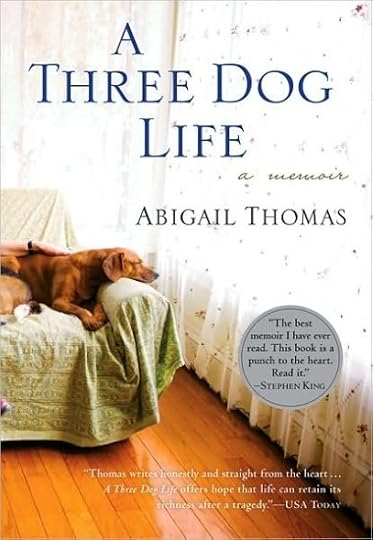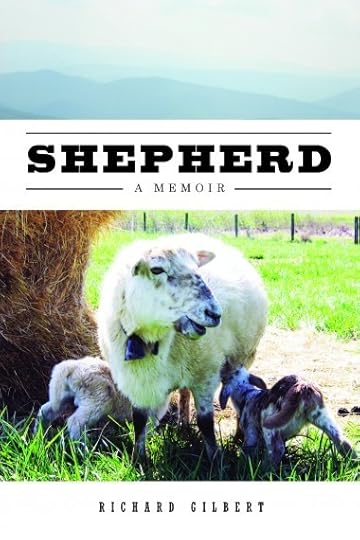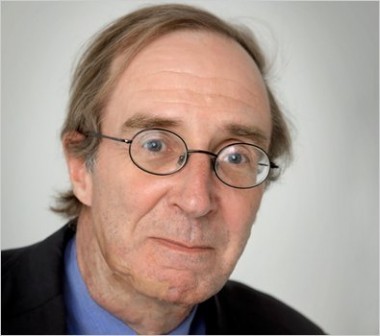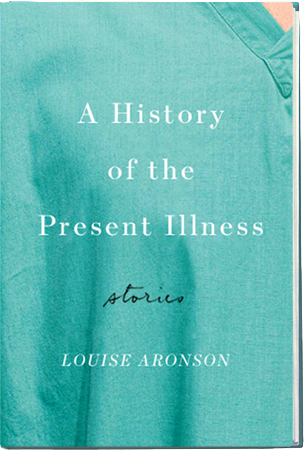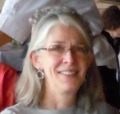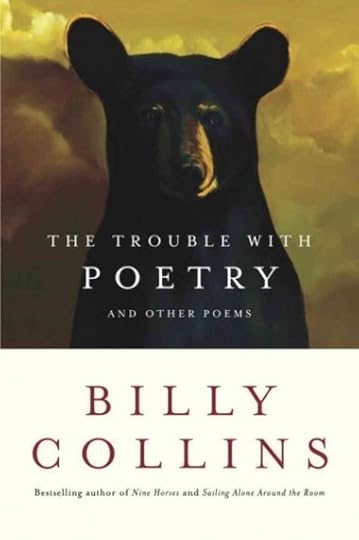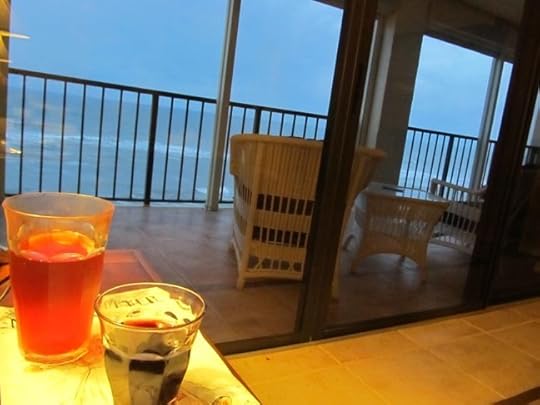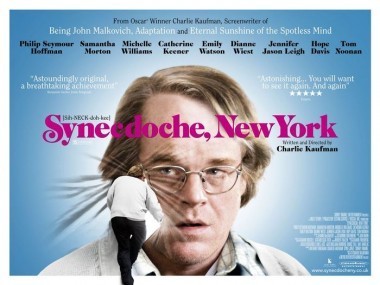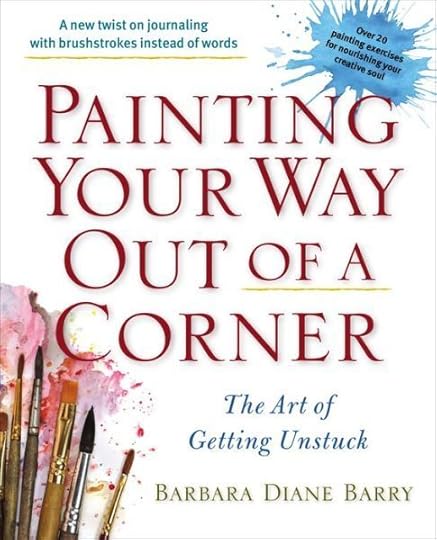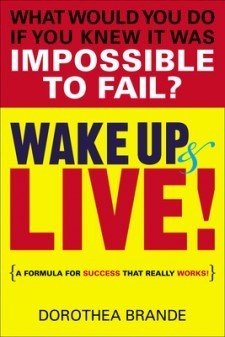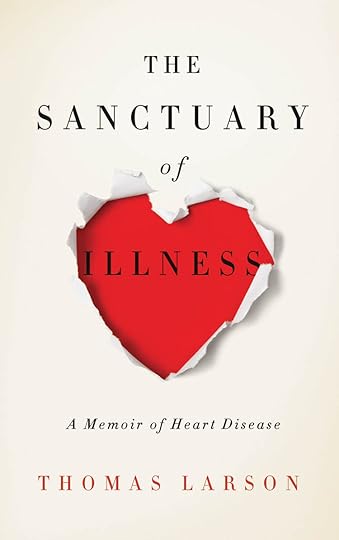Richard Gilbert's Blog, page 13
April 7, 2014
Writing Illness

[Tom Larson reads to my "Writing Life Stories" class, Otterbein University.]
Thomas Larson on the body’s honesty.
A memoir is a work of literature that focuses on the meaning and intensity of a phase or a singular relationship in the author’s life—unresolved feelings for a parent, a child, a sibling, a friend; coming to terms with a loss, an illness, a death; remembering a significant phase like childhood or adolescence or a period like college in which the writer was challenged or changed.—Thomas Larson’s lecture “Finding Ourselves: Writing Memoir and Jungian Individuation”
Illness is a theme of my “Writing Life Stories” class this semester. The students noticed it, not me. But then, four are nursing majors. In one of our texts, Lee Martin’s collection of memoir essays Such a Life, his father’s traumatic accident that cost him his hands casts a shadow across every line; and Martin explores his own boyhood bout with thyroid illness and his middle-age health crisis, an ordeal of corneal abrasion. Running through another of our main texts, Jo Ann Beard’s The Boys of My Youth, is her mother’s illness and death from cancer.
Then Thomas Larson visited last week.
He’s got a new book out, The Sanctuary of Illness: A Memoir of Heart Disease (my review and interview), and my students had read its powerful first quarter, which depicts Larson’s first heart attack and its aftermath. They also read his essay “The Woman on the Corner,” about his grandfather’s suffering and death from cancer and their effect on his grandmother. In introducing Larson, I also prepped the class by mentioning his book The Saddest Music Ever Written: The Story of Samuel Barber’s “Adagio for Strings” (reviewed), and I played part of a YouTube performance of “Adagio for Strings” with 5.8 million hits: a concert three days after the 9/11 attacks.
My students really wanted to know how Larson can write so personally about himself, his family, his body. Last year, this was also among the first questions for Lee Martin during his visit. Many beginning writers wonder about this, I think. And all memoirists. “No one tells everything,” a writer once told me. But writers tend to view their experiences as material, as something to make art from, whether fiction or nonfiction.

[Just open a vein . . .]
Last Wednesday, Larson read a passage from The Sanctuary of Illness about his older brother’s decline from heart disease, and then I kicked off the Q&A by asking him about revealing one’s and others’ private matters. “It’s always a bit difficult,” Larson confessed. “Because I’m remembering my brother, who’s dead. Who I talked to on the phone. If you don’t feel that, you’re not here. It’s a reason to write. . . .
“I don’t think of memoir as an act of revenge,” he added, “but as an act of communication.”
The subject wouldn’t die, entwined as it is with memory—that shape-shifting muse, the storm- and breeze-breeding equator of our emotional weather. Facts, Larson said, are less important than one’s emotional memory. A student asked him how he summons memory. Larson rolled up one of his shirt-sleeves, as if baring a vein to give blood:
The sensory is the most honest part of me. My body does not lie. The words are in your body. In smell, in your fingertips. I can feel my father’s touch and the stubble of his cheek. What’s hard is to occupy the past in the present. Writing details is how you occupy the past.
Never go in with your message and meaning foreknown, he advised. Look instead for what’s unresolved in you. Maybe it’s when you were ill and let down your guard, had no energy for your usual armor.
On Saturday, a few miles from campus, Larson attracted 16 patrons of the Old Worthington Library to his two-hour workshop on writing about illness. “The canvas is massive,” he told them in the library’s meeting room. “And it can also be about caretaking someone with an illness. With both, there’s going to be a relationship. Memoir writers are not just interested in the ‘I’ or the self, but about how they fit into the world.”
Wisely, I think, he avoided having everyone in the room discuss, in turn, the particulars of their illness story. But he did give us ten prompts about illness—including our main characters, our story’s high and low points, our envisioned audience, and our motive—and then he paired us off to share. Attendees ranged in age from mid-thirties to mid-eighties, and I was surprised by how well-read they seemed in the memoir genre. At least some were, as well, veterans of other writing workshops or classes.
In the second hour, Larson read aloud from and we discussed excerpts of two fine and very different illness memoirs: Intoxicated by My Illness and Other Writings on Life and Death, Anatole Broyard’s cerebral, wry, expository account of his battle with terminal prostate cancer; and A Three-Dog Life, Abigail Thomas’s spare, sensory, scenic depiction of living with her husband’s traumatic brain injury.
As for the progress of anyone’s disease becoming plot: “It’s not the thing itself,” Larson warned. “It’s how we respond to it.”

[Larson leads a workshop on "Writing About Illness," Worthington, Ohio, library.]
March 29, 2014
1st review of my book
In the wake of Amazon.com just updating my book’s page with complete blurbs and information, comes a generous and discerning review of Shepherd: A Memoir by Shirley Showalter. My book’s first review!
I’ve learned how vulnerable a writer feels before those first reviews arrive. Though you labored to simplify, clarify, and dramatize key elements, you’ve also tried to convey your story’s complexity. You fear that a review will over-simplify or distort. At the same time, you realize you’re too close to your own narrative—you spent years writing it but don’t know how it comes off. How you come off. But Shirley really got my story. And I’m beyond thankful—I’m grateful.
Another recent notice is in the form of an interview with me on Learnist, conducted by Maggie Messitt. I met Maggie years ago at Goucher College, where we both earned MFAs. Now she’s a doctoral student in creative nonfiction just down the road at Ohio University.
Maggie’s first question was “What was the story’s driving force?”

[Writer Maggie Messitt.]
During the years I was writing Shepherd, I told myself, “This is a story about fatherhood, farming, dreams, and loss.” And so it is. It’s about a middle-class couple who move to a beautiful, impoverished backwater, Appalachian Ohio, and get a farm and start raising sheep. As they learn to love the challenging region, they suffer culture shock and mishaps, including a disastrous house renovation, animal deaths and disease, and human injuries. Against that foreground story are flashbacks to my truncated farm boyhood, to my father’s boyhood in which a farm in Michigan was a refuge after his father’s suicide, and to my wife’s sunny farm girlhood in northwest Ohio.
My father sold our family’s farm in Georgia when I was six, and after that I grew up in grieving for it in a Florida beach town. I was living in paradise but couldn’t see that. I had this pent-up desire to get a farm and to redeem my father’s dream. I did that and actually ended up buying two adjoining farms; the experience of farming seriously, for over ten years, was joyous and painful and deeply instructive.
But the book’s driving force was very simple. I yearned to write this story so that people would understand what it was like to obtain the most magically beautiful farm in Athens County, Ohio, and to lose it by overreaching. And why I was okay with that, when I’d have predicted it would have killed me, given my disturbed and dreaming boyhood.
The Learnist format is graphically impressive. In their interviews with authors format, a standard feature is for authors being interviewed to pick five questions from a stock list:
In the late nineteenth century, lists of questions were a popular diversion, a parlor game of sorts, designed to discover new things about old friends. Apparently, when Marcel Proust was a teenager, his friend Antoinette Faure asked him a list of 35 questions. Years later, Proust was asked those same questions for a second time and his answers were published on a French album in 1892.
I tackled: “What is your greatest fear?”; “What is your current state of mind?”; “What do you consider the most over-rated virtue?”; “What or who is the greatest love of your life?”; and “When and where were you happiest?”
I’ve just completed a second interview, very wide-ranging, with Daisy Hickman of Sunny Room Studio, where I once wrote a guest post on my spiritual influences. That interview is scheduled to run April 11—which is about when Shepherd should get its advance trade press reviews.
If Michigan State University Press’s campaign has been successful . . .
How to win advance trade press reviews
Waiting for my book to arrive, I’ve felt strangely adrift. Although its publication date is May 1, books go on sale on or about April 15. Which is about when I’m hoping for advance reviews in the trade press: Booklist, ForeWord, Kirkus, Library Journal, and the biggest dog in this pack: Publishers Weekly.
Advance notices are important because they’re read by major reviewers, editors, and booksellers. Not to mention by Hollywood producers and directors. (Note to Wes Anderson: My wife would love Meryl Streep to play her; Brian Cranston could certainly do justice to me, though, knowing you, you’ll probably cast Bill Murray.)
But my true hope is simply that by getting advance reviews, Barnes & Noble will stock my book in its stores. It is listed on the B&N website. But the physical book world is still old-fashioned, and a web notice doesn’t mean my book will enter a bricks-and-mortar building.
I campaigned for books for 11 years at Indiana University Press and Ohio University Press/Swallow Press, where I ascended to marketing manager and also helped acquire books and reprints, including the classic farm memoir RFD, by Charles Allen Smart, The Sheep Book, by Ron Parker, and All Flesh is Grass, by Gene Logsdon. It still surprises me how few authors (and smaller presses) know how the game is played.
Here are the steps:
• Ideally, go to New York once or twice a year and hand major trade press and elite editors your catalog page proofs. Pitch only a few books; you can destroy your credibility by pushing a book they don’t consider a “trade” (i.e. having potential wide appeal) title.
• Follow up with the catalog and a letter confirming the galleys you plan to send, based on what was requested.
• Send each reviewer a personal letter and bound galleys made from first page proofs—often also called Advance Reading Copies or ARCs. These must be sent a minimum of four full months before the stated publication date. If need be, you’ll say you’re pushing the pub date back; pub dates are guesses, kind of fictional, anyway. For my book, with a planned pub date of May 1, trade and elite reviewers (New York Times, Washington Post, etc.) had to receive galleys in December, giving publications four full months—all of January, February, March, and April—to plan and prepare reviews.
• Send a letter (or two or three, spaced out) early in the period before publication announcing major blurbs, the final cover, or subsidiary rights sales. If there’s buzz, it’s easier for trade reviewers to get on board.
• Using Filemaker Pro database software means your various and ongoing pitches and mailings are less than onerous.
Winning advance reviews is just this easy and just this hard.
[Charles McGrath, former Book Review editor.]
I brought procedures for book campaigns from Indiana University Press, a powerhouse Midwestern academic and literary publisher, to smaller Ohio University Press in its backwater in the Appalachian foothills of Athens, Ohio. Using them, I managed to get one or two reviews a year in The New York Times Book Review. I met in person once a year with the then-editor, formerly of the New Yorker, Charles McGrath, now writer-at-large for the Times; he was a friend and golfing buddy of John Updike’s! Though my visits with Mr. McGrath could be measured in minutes, he was being both book-world respectful and personally kind to see me.And our books got regular notices in the big four advance review outlets: Booklist, Kirkus, Library Journal, and Publishers Weekly.
Publishers who can’t afford to send a representative to New York cut their slim chances by about 50 percent. Lack of hand-selling is a real obstacle to overcome. Then, if they send ARCs late, or with just a press release and no personal letter, there’s no way on God’s green earth a book will get an advance review. Believe me, there’s no penalty for the New York publishing world in overlooking a great book from a tiny press. They cannot afford to do that with Random House—whose rep, in any case, they know on a first-name basis.
Having said all this, what if I get what I’ve wished for—legitimizing trade press notice!—and my book is panned? I’ll have to eat the words I have told so many authors over the years: “A mixed review in Publishers Weekly still means they thought your book was worthy of notice. And many readers will think, ‘Well, I think I would like it.’ ”
Yet I know that the only review I ever tried to hide from an author appeared in Publisher’s Weekly. A total massacre and, I felt, mistaken. Alas, Amazon loaded it prominently on the book’s web page. And the author’s friends helpfully called her attention to it. She wanted to protest; she wanted names. I knew that would do no good. To preserve reviewers’ goodwill toward me and therefore toward our other books, I couldn’t allow it. So I refused to help.
An author should doubly rejoice, therefore, in the kind of positive reviews and notices my book has just received. And I do. Because, in my experience, sooner or later, an author will have to take his lumps.
March 20, 2014
Stories of medicine & society
A History of the Present Illness: Stories by Louise Aronson
Bloomsbury USA, 272 pp., $24.00 hardback, $16.00 paperback. Also available in ebook versions.
Guest Review by Lanie Tankard
Everyone who is born holds dual citizenship,
in the kingdom of the well and in the kingdom of the sick.
—Susan Sontag, Illness as Metaphor
Louise Aronson’s book of short stories, A History of the Present Illness, was published in 2013, and just came out in paperback a few weeks ago.
Each protagonist in the sixteen tales, all set in the San Francisco area, is a different doctor treating a new patient, but Aronson varies the voice, the gender, the age, the venue, the disease or circumstance, and the background of both. As we turn the pages, either physically or electronically, we view assorted scenarios through the eyes of a changing cast of physicians as the dramatis personae move from one theater to another. Aronson examines the traditions of their globe-spanning histories as if she were watching culture grow in a Bay Area petri dish, so much do these immigrants vary.
The author, a doctor herself, describes these fictional cases in a dispassionate, clinical manner while at the same time imbuing them with an underlying humanity that explores the ethos of the events. Not all the characters are likable. Aronson details the course of an illness alongside the complexities of assimilation in a different nation with a minimalist touch. The characters inhabit a shared community within a medical setting—which represents yet another new nation in which they must adjust to an unfamiliar culture.
Aronson maintains a running commentary on the surrounding society all the while. She notes in passing, for example, the architecture of prisons as she gradually peels back the layers of a psychiatrist designated to determine for the court how a prisoner (who is a doctor) came to be where he is. One encounters moments of brilliance here, such as when the physician under examination realizes for the first time what “doctor mode” actually looks like—a demeanor that a medical person “could apparently turn on or off at will.” He mulls over the ensuing “silence standoff” between himself and the psychiatrist, allowing the reader in on his musing.

[Dr. Louise Aronson: fiction as "metadiagnosis."]
Despite a dry wit at times, such as the description of a medical student’s first patient—the med school cadaver, Aronson requires the reader to ponder tough questions by having the characters pose them to one another: “’What makes a life worth living?’ she asked. ‘And who has the right to make that decision?’” A few sentences here and there are weak while others are pure poetry, as when the author employs the phrase “a once-blind man” as a metaphor.
This collection of fables is meaningful not only for its allegorical and literary worth, but also for the uncluttered techniques it utilizes to posit the dilemmas of our collective impermanence. Merriam–Webster defines diagnosis as “the act of identifying a disease, illness, or problem by examining someone or something, or a statement or conclusion that describes the reason for the disease, illness, or problem.” It is the job of those in the medical profession to produce diagnoses. What Aronson has attempted in her book is a metadiagnosis, a valiant search for meaning underlying her work. That theme is a running thread throughout the course of these unrelated stories.
How does a doctor accomplish a diagnosis? Past medical history (PMH) can give an overview, but then determination of the chief complaint (CC) is needed. The next step in a medical examination entails taking down a history of the present illness (HPI), which includes aspects such as location, severity, onset, duration, and aggravating factors. It is the last facet, the provoking influences of these fictional maladies, with which Aronson seems most concerned. And it all feels so true that one senses the author has lived every one of these narratives herself. The book is suggestive of an Appendix to the Merck Manual addressing overlooked aspects in medical training from a humanistic angle.
The entire Merck, by the way, is available free online in its most recent edition for anyone to peruse. I found it fascinating reading. Under “The Dying Patient” is the subsection “Care After Death,” which counsels a doctor to use clear language when communicating with the family, avoiding euphemisms such as “passed on” in favor of “died.” The stories in Aronson’s book deal mostly (but not always) with end-of-life issues—yet of course, the author (a doctor) specializes in geriatrics. A broader spectrum of cases would have brought in variety, but what is present draws strength from being what it is.
We who are patients gain much from learning to see ourselves as doctors see us, perhaps becoming better partners in the management of our own health after we comprehend how physicians are created and how they make decisions. Yet A History of the Present Illness offers far more to consider. It’s a valuable addition to the ever-growing collection of works in the medical humanities, called “medhum.”
Susan Sontag once wrote: “literature remains one of our principal modes of understanding.” Aronson exemplifies Sontag’s idea by opening wide the windows of her hospital for us. We sense her presence on every page, in each story, her stethoscope wrapped around her neck observing the total picture. Her memories guide her writing as she bears witness through fiction to what she has seen.
Here is a video of Louise Aronson discussing her book.
Lanie Tankard
Lanie Tankard is a freelance writer and editor in Austin, Texas. A member of the National Book Critics Circle and former production editor of Contemporary Psychology: A Journal of Reviews, she has also been an editorial writer for the Florida Times-Union in Jacksonville.
March 13, 2014
Content + Craft = Art
Lessons learned teaching creative nonfiction to non-majors.
This is the second Spring I’ve taught “Writing Life Stories,” which is creative nonfiction for non-majors, college juniors and seniors. As always, this class underscores for me writing’s good news/bad news situation: writing talent is common. Among about 20 students, one is a writing major, and several others are avowed artists—of ceramics, music, theatre—but the largest single cohort this year is nursing students, who are doing impressive work. The most advanced writers, as always, are readers and journal-keepers, or who were in childhood, whether they’ve ever taken a creative writing class or not.
The first night I drew on the chalkboard a huge circle with an arrow from it to an equation: C + C = A. The circle is the vast self (which to me includes the collective unconscious of our species, though I don’t go into all that). The first C is in a rectangle and represents what the self is given to work with, which is content—the self’s encounter with the world. Both the circle and the first C are black-box mysteries, as far as teaching is concerned.
The second C is craft, and the line that flows onward from it goes to A: art.
“Craft is what releases art,” I told the kids that first night. “And art announces itself in form.”
While talent is common, the higher levels of craft are not, so craft is our appropriate focus. If I’m wrong, at least I’m clear. And let’s face it, clarity is rare in this world too. Looking back, I’ve made mistakes in teaching—just as I’ve lamented some of my shoot-from-the-hip posts here—but an instructor’s passion counts for a lot, as in blogging, even if he later views his ideas as half-baked or his execution as inept.
I’m sure I’ve gotten much better at teaching craft, though. I thought I did a good job last year but feel so much more successful this time. In part this is because of their work and in part because the class feels more successful simply because I’ve gotten the kids to better discuss readings. I did that by assigning two or three students to lead our reading discussions each session. As well, like last time, I have two or three read aloud four-page versions of their essays. Another hour is consumed by a writing prompt, group work, or individual conferences.
The class, however, is kicking my butt, which partly explains my recent difficulty in posting on schedule here. I’m halfway through my sixth year of blogging, and for most of that time have posted every five days. Lately I’ve struggled to meet my more modest goal of once a week. As an example of the class’s role in this, I just read, edited, graded, and commented on about 200 pages of student memoir essays. I did this electronically, using Word’s markup function, which requires much more time and precision than does reading hard copy but which results in a clearer and more permanent edited copy for students. Plus it saves me writer’s cramp.
“Writing Life Stories” is a hybrid class, meaning we meet partly on line and once each week in person. The reading discussions begin each Sunday on line, followed by uploads of essays for oral readings, comments on others’ opinions about readings, and mass uploads if a major essay is due. By Tuesday morning, I start really boring in on my preparations for Wednesday night’s class, a hard day-and-a-half process of planning the class and roughing out the following week’s (the latter necessary because of the need to have their homework assignment ready). I presume the students begin kicking it on Tuesday as well, since whatever else is happening on line, they owe me hard copies of their Reading Journal and Writing Journal, which totals three and a half to four pages from each of them.
![[The delightfully dark Ms. Vowell.]](https://i.gr-assets.com/images/S/compressed.photo.goodreads.com/hostedimages/1394791287i/8907069.jpg)
[The delightfully dark Ms. Sarah Vowell.]
Our “textbooks” so far, three essay collections, are pretty generally hits: Lee Martin’s Such a Life; Jo Ann Beard’s The Boys of My Youth; and Sarah Vowell’s Take the Cannoli. Martin is a master at invoking the wiser retrospective narrator even in the midst of compelling or dramatic scenes; he’s the most balanced writer, technique-wise, and I’ve pushed his work hard. Beard writes almost purely in scene and loves the powerful and satisfying braided structure, as in her famous essay collected in this book, “The Fourth State of Matter.” Vowell is funny and expository, a cultural critic or journalistic commentator as often as she’s writing memoir—she’s a great personal essayist, using the self to inquire into the world. Finally we’ll read a cohesive book-length narrative I’ve never taught, Michael Perry’s Population 485: Meeting Your Neighbors One Siren at a Time. I figured these small-town Ohio kids will find it, as they say, “relatable.”
I also have them read essays by Jill Christman, Thomas Larson, Dinty W. Moore, and others. Stand-alone essays from my files, especially flash and innovative forms, are how I nudge undergraduate students beyond their fondest desire: a strong story (meaning one driven by event sequence, ideally dramatic) and a protagonist they can identify with.
As I mentioned recently, my overarching focus this year is the triumvirate of persona, scene, and structure. It’s thrilling as a teacher to see students directly apply the tool’s you’ve handed them. So yes, Virginia, writing can be taught! Talent can’t—but as I say, talent is common. There’s no telling who’ll become a Writer, of course, but that has more to do with desire and perseverance (which, I concede, talent may fuel).
Some of my students are almost giddy to discover that this genre called creative nonfiction exists. “You can do anything you want,” I tell them, “as long as it works.” How many teachers have told them that? Anyway, for now they are as pleased as I am that, as we march into Spring, which slowly but surely is returning once again, they’re using their experiences to make art.
February 28, 2014
Teaching memoir’s essentials
They say the best is still yet to come
but the taste of you is still on my tongue.
I can’t forget and I won’t even try
to erase your image
and the way you made me cry.
I’m learning how to live.
—Lucinda Williams, “Learning How to Live”
For my second year, I’m teaching “Writing Life Stories: The Power of Narrative” to a class of college juniors and seniors. There are 19 students this year, only one a writing major, though several others are declared artists—of music, theatre, ceramics, film—among the future nurses, veterinarians, and teachers. In short, this is creative writing for non-majors. For the seniors, it’s their final semester. Their last chance to take a “fun” elective. Perchance to reflect, to second guess, to move forward.
I loved last year’s class, but feel I’m doing a better job this time. I’ve codified everything learned last time—and from many other journalism, memoir, and cnf classes I’ve taught or taken over the years—into a focus on three essential elements of personal narrative nonfiction. In practice, I know, you must teach much more than that at once. I harp on sentence diversity and rhythms from the start, for instance. Writers must learn to do so much at once, which is what makes writing challenging. Some talents do burn bright and quick, but I think of writing as a comparatively late-blooming art. Though I may change my tune by the end, for now I love the focus provided by telling the kids from the first day that our three big tools for reading and writing memoir are persona, scene, and structure.
Persona
In an essay, I’m always interested in the opening to see what the writer wants me to pay particular attention to, and often that ends up being the layers of the persona which are in conflict with one another.—Lee Martin

[Lee Martin: jedi memoir master.]
I can’t remember where I ran across this comment by Lee Martin, probably on his excellent blog, “The Least You Need to Know,” but it seems so acute. It points to the fact that any persona (the self the writer creates on the page) is only so cohesive—and that personas from different time periods are likely to be totally different and even interestingly hostile to one another.
Martin, through his craft essays and memoirs, has taught me more than anyone about the use of persona. Point of view, voice, and tone all arise from or are inseparable from persona. I’ve become increasingly sensitive to the richness for readers in the fact that at least two distinctive and different voices from the same writer can tell the story in memoir: you “then,” mired in the action, and you “now,” the wiser person telling the tale.
Surely this reflective narrator is embedded in our DNA. After all, we first must have received stories of epic hunts, gory battles, or wild berry bonanzas from those who survived them or witnessed them from close at hand. Martin is a master of setting an essay vividly in the past but occasionally commenting on the action from his desk—“All these years later . . .”—and he can do it even in the midst of a dramatic scene set far in the past. Hence I first have my students read his masterpiece “Never Thirteen” from his collection of memoir essays Such a Life.
(See my interview with Martin and review of Such a Life, or my post on his visit last year to my class, “The Artist Must Risk Failure.”)
Last Wednesday night in my memoir class, I overheard a student say to another in workshop, “I think you could really use the retrospective narrator here.” Hark—a comment as thrilling as spring’s first daffodil! None of this is rocket science—then why is it so hard?—but I’ve given them a vocabulary at least, and by gum they’re using it.
Scene
If you resist making a scene, don’t write a memoir. Sit quietly in a church instead. Memoirs are made up of particulars and scenes, in which people speak and act. We need to find the moments from our lives that affected us in some way, and we need to dramatize them on the page. This scenic writing allows readers to feel as if they’re participating in your life rather than merely watching from the audience.—Lee Martin, in a recent post “Ten Thoughts About Writing a Memoir”
When I first taught long-form narrative journalism, I emphasized persona and scene. I threw in persona because I was influenced by a teacher I’d known who was obsessed by persona, probably because the teacher’s own prose persona was relentlessly opaque. I soon realized that, in journalism, persona should be present—that is, the story should somehow acknowledge that a person working as a writer made it—but that persona’s apparent relevance and the freedom to make it relevant are usually severely constrained by various forces. In contrast, as Vivian Gornick says in The Situation and the Story, “From journalism to the essay to the memoir: the trip being taken by a nonfiction persona deepens, and turns ever more inward.”
Scene is the main tool a journalist has going for her, but I’ve noticed that journalism students resist the hard work of scene-by-scene construction, while they grasp quickly the quick-and-dirty scenic lead, the false promise of shared experience. (Let’s face it, though: scenes you witness and certainly those you must report for are harder to write than those you can summon and spotlight in the theatre of memory.) And by the same token, dramatized action often is subtly or overtly dissed by reviewers of literary memoirs. Thus my love for Martin’s fierce comment above.
It’s been interesting this semester to see which students seem naturally to write in scenes and which ones tend to tell the story. Scenes seem like hard work to me, much as I love them, but some students the other night said they find them easy.
Whereas Martin’s work is beautifully (and powerfully) balanced on the continuum between scene and exposition, our reigning Scene Queen model writer is Jo Ann Beard in her memoir collection The Boys of My Youth. What an amazing writer—whose use of the retrospective narrator is rare and exceedingly subtle. (We’re also reading Sarah Vowell’s amusing Take the Cannoli, which is highly expository and told exclusively by the retrospective narrator.)
Structure
It is basic, our need for story, perhaps because it is such a handy way to carry our experiences around—story as container, so to speak. But the shape can be anything at all. So you can think of your memoir as a soup pot, or a trapeze, or a funnel, and if this helps you, great. What helped me was deciding what my memoir wasn’t going to be—it wasn’t going to be shackled by chronology.
My advice is to start writing and continue writing. A shape will eventually suggest itself to you. . . . [Y]ou must trust the writing and the shape will appear.—Thinking About Memoir, Abigail Thomas

[Jo Ann Beard: scene & structure queen.]
I added structure as a stated focus this year because I tried to kind of build up to it last year, and one student said he wished I’d done more from the start. The only structure I’m delaying this year is the segmented.
When I started teaching creative nonfiction, I thought students first should learn to tell a story traditionally, by which I suppose I meant chronologically. Now that’s not so clear to me. Since art announces itself in form, making a chronological account scream Art—therefore answering the mulish doubt Why should I read this?—means that every aspect, from words to sentences to punctuation to paragraphing, must work at a high level. Without that, caught in chronology’s trap of telling too much, the story will plod.
Yet Martin’s Such a Life showcases one chronological gem after another. I try to show students how his flowing memoir essays achieve their effects. Such as starting in the midst of action, riveting us with scenes, deploying the dual narrator, and stoking the narrative’s fire with rising action while artfully withholding certain aspects till the right moment.
Having said this, I’m getting results with two other forms that students find exciting and that they instantly grasp. First, there’s the framed structure, which draws on the power of scene: embedding us in a dramatized moment at the start, it flashes back and picks up the action, moving us toward the essay’s close in which the opening scene is resumed and resolved.
Second, there’s the braided structure that alternates between two or more related stories, sometimes happening in different time frames. An example in film is Sean Penn’s wonderful adaptation of Jon Krakauer’s deft personal-journalistic inquiry Into the Wild. In that case, one thread is the 113 days Chris McCandless spent living in the Alaskan bush and the other depicts the roughly two years of wandering that culminated in his northern adventure.
Jo Ann Beard loves braiding and uses it in several essays in The Boys of My Youth, most famously in “The Fourth State of Matter,” which was first published in the New Yorker. (There’s a thrilling explication of this essay by Jill Christman at Essay Daily. ) I’ve written a lot about the braided structure here, including about my essay “Wild Ducks,” which appeared in River Teeth.
I’m still trying to figure out how to teach the segmented structure. Last year’s results were encouraging, but some students got confused by my main prompt. Maybe I’ll do better this time. Among other models, students really like the flash essay, though should this short form be called a structure? Anyway, such lyric moments—whether pure scene or reflective exposition—live close to poetry, blurring the taxonomy of genre.
And students this age are still flaring with poetry. What joy to help them find it. Yet seeing college careers end with my class is always so poignant. When the glory of late spring comes at last, there they’ll go, flying like valiant sparrows into their futures, into the snarling storm’s very teeth.
He had a reason to get back to Lake Charles.
He used to talk about it.
He’d just go on and on.
He always said Louisana
was where he felt at home.
He was born in Nacogdoches.
That’s in East Texas,
not far from the border,
but he liked to tell everybody
he was from Lake Charles. . . .
We used to drive
through Lafayette and Baton Rouge.
In a yellow Camino,
listening to Howling Wolf.
He liked to stop in Lake Charles
’cause that’s the place he loved.
—Lucinda Williams, “Lake Charles”
February 13, 2014
Emotion becomes an essay

How art gives rise to art & bends toward poetry.
Thou Child of Joy,
Shout round me, let me hear thy shouts, thou happy
Shepherd-boy!
—from “Ode” by William Wordsworth
Every winter I find myself turning briefly to the Romantics, and I partake of Wordsworth and Keats, there on the treadmill in the basement, staring at an old mass market anthology, yellowed and torn. But it’s been sustained, my poetry reading, this cold and snowy winter.
It began with seeing a couple of surfers in mid-January. I was down in Florida, staying at my sister’s condo on Melbourne Beach, a few miles down Highway A1A from where we grew up in Satellite Beach. My wife and sister had left, and there I was alone with the dog. My schedule was to read Anna Karenina, and then work on planning my Spring classes, and then take the dog for an hour’s walk. Sometimes I got out rather late. Like the day at 4 o’clock when, in a silent empty subdivision, I witnessed two boys roaring toward the beach on skateboards, their surfboards under their arms, and I tagged along and watched them surf.
The episode triggered a confused longing in me for my own beach-town boyhood—but also a surging hope: gladness that kids were still growing up partaking of oceanic gifts. And also I felt a comfort in this new human wave that’s rapidly overtaking me; it will seem fitting and proper when I dissolve into that bottomless, fathomless sea of DNA from which they’ve arisen. At least I hope so.
The emotions I felt from seeing those surfer dudes, the embodiment of my own beach boyhood, were such a welter of loss and love that I wanted to capture the experience of witnessing them at play in the waves. But for three days I didn’t know how. What form might such a piece take? I should at least journal about this, I thought. But I’m a lousy journalist. (Journaler? I was a handy Space Coast newspaper reporter back in the day.) I kept thinking, How can I let that moment pass? Not make something?
~ ~ ~
. . . I don’t wish to add
to my sons’ sorrow. If I could play three notes
upon the fiddle, I’d do that instead.
—from “What I Told My Sons after My Father Died” by Todd Davis, collected in In the Kingdom of the Ditch

[Kim Adrian.]
In the midst of my dithering, I reviewed Thomas Larson’s new memoir for Brevity’s Nonfiction Blog, and writer Kim Adrian followed a link to my site and commented on my Q&A with Tom. I went to Kim’s website in turn, and read some of her fine work there. I was intrigued by the title of one of her essays that was listed but unlinked, “Questionnaire for my Grandfather.” It appeared in Gettysburg Review in Winter 2009 (Volume 22 Number 4), and I tracked it down, reading it electronically thanks to my university library’s database affiliations. Kim’s piece concerns how her grandfather’s molestation of her mother affected her mother, and therefore her. The form Kim adopted—a formal questionnaire with increasingly personal questions for a man she never knew—makes the unbearable tolerable, and its surprising form bespeaks a powerful artistic shaping of experience.
I felt impelled to try that approach, and began writing an essay in the form of questions to the surfers. (Thus does art give rise to art—in a way that seems as necessary as experience itself. Without Kim’s essay, I might have let my moment at the beach drift for a few more days and lost it forever.)
After I had a draft, my early excitement and pleasure shaded, inevitably, into dissatisfaction. One dilemma was that I couldn’t decide whether to work in both of two aspects at the end: that I drew energy and hope from the surfers’ native-animal rightness and that they provided solace for my faster-moving fate. Somehow both elements gave me faith in the future of our species. Those boys, there atop the cresting wave that shadows me, whether they become architects, accountants, or Navy Seals, will have their beach days for all their days.
As I tried to refine those culminating feelings, I sent a draft to Tom Larson, with whom I had been emailing in the wake of his interview. He suggested dispersing the feelings: “Something is expiated but I’m not sure it has to be stated.” I felt I needed those emotions to cap the event, as they did in life, but he offered an even more challenging idea: to end on an image I’d used of me. As it was, I’d placed it just before the feelings: I’d impulsively pulled out my iPhone and, standing awkwardly on my dog’s leash, had tried to take a photo of the surfers.
“We had a poet come to Ashland [University] last summer, Keith Flynn,” Tom wrote, referring to the low-residency program in Ohio where he teaches. “He had many great lines. One was, begin the piece/poem in drama or action; leave it in motion.”
~ ~ ~
“If you want to write a topic that’s rather large, you use an image as a point of entry rather than taking on the topic in a frontal way.”—Billy Collins, in the intro to the video above of him reading “The Lanyard”
Finally I did disperse some details, if not the major emotions. And I tried ending with that image of me trying to capture something permanent from a fleeting encounter. Though I sensed Tom was right, the new ending was hard to get used to. Did it put too much emphasis on what could be seen, at the expense of what was felt—on image over meaning? And yet, it grew on me, a closing emotionally resonant yet grounded—my feelings made flesh.
Meanwhile I kept fighting with what was now the penultimate paragraph: those big emotions and their meaning.
What you’ve got here, I told myself, is a Billy Collins moment.
WWBD?
Billy Collins? What’s he, the gateway drug of poetry? You could do worse. Maybe some poets would dispute that. Back in the ‘70s it was wildly popular Rod McKuen who got no cognoscenti cred or respect—playing tennis without a net and all that. But the question here is really what impelled me to read Billy Collins, and thus Todd Davis, and—in three shakes of a lamb’s tail—to find myself ransacking the shelves for William Carlos Williams. (Where is Dr. Williams when you need him? He hasn’t paid a house call here in many a moon.)
Turns out, having returned to Ohio and read three collections by Billy Collins, I’m not sure what he’d do. Because he never has such a Billy Collins moment. Or rather, many of his poems are moments but his are funny. My essay’s a murky soup in comparison with his wry musings on household objects and his affable dry-eyed riffs on mortality.
Still, I read, hoping to absorb something. Some way of handling my urge toward epic pronouncement. At first I played a little game with some of his poems, mentally taking out line breaks and grouping lines and stanzas into paragraphs, forming essays similar to my surfer lyric. I like Collins’s poems partly because they don’t read like Poetry—like what I’d write as poetry, too intense and elliptical—but instead are akin to little essays, somewhat like what I do write, or might.
Yet there remains the dilemma that Billy has refused to help me with: whether to risk in my short essay doing both—celebrating those boys as fine native animals and having their meaning comfort me in my own animal fate—when neither aspect can be developed in my flash piece in a stereotypical essayistic way. Which hasn’t stopped me. You write a sentence and see what it says. That leads to another sentence. All of which leads to discovery of meaning and to angst over meaning.
My monkeying, however, has distressed friends and family who loved the early draft I shared from the beach. They feel I have ruined it, over-worked it. They don’t understand that the standards for form are so high for Art. Which in practice means that it takes so much to please my fellow-writer gatekeepers and to overcome their resistance to mere emotion or lack of craft. That the longer you spend with a piece, the more you see not only its flaws but its own bent toward clarity of emotion and meaning.
Alas, they do understand that something precious can die a-borning. That it may take more talent than I have to sharpen and perfect a piece while retaining the magic of a heartfelt first draft. Maybe that’s what takes genius? Being able to do both? To catch the ineffable first wave of emotion and reflectively shape its expression?
So I turn toward poetry, as if by instinct. Of course the affinity between nonfiction and poetry has long been noted. But it can help anyone writing anything, or any living soul, to paddle toward poetry. You’ll capsize in some of it, but then you’ll find a poet, like old Billy, who seems to have been reading your emails.
February 6, 2014
Art and suffering
Philip Seymour Hoffman & Edmund Wilson’s Wound and the Bow
I.
I bleed by the black stream
For my torn bough!
—James Joyce
One afternoon in the winter of 2008 I fast-walked across a frozen landscape to our town’s art cinema on the edge of the campus where I worked. I snuggled down in my seat in the dark empty theatre, still wearing my black overcoat, having just finished teaching, and watched with growing amazement Synecdoche, New York. It had premiered at Cannes in May, and had made it finally to our wintry corner in Appalachian Ohio.
The script by Charlie Kaufman and the performance of Philip Seymour Hoffman were equally astounding—like nothing I’d ever seen on film or dreamed of seeing. The film’s plot is at first easy to follow. Hoffman plays a theatre director whose genius and ambition far outstrip his paltry achievements; his wife is an artist whose paintings are, in significant contrast, such miniaturized images that they require special glasses to view. Though he loses his wife, who takes his daughter to Berlin and becomes famous, he wins a MacArthur genius grant, and with it enough rope to hang himself. He pours his money and life into a vast warehouse set that’s peopled with actors who endlessly portray aspects of his past as he ages and disintegrates. The film gets weird and challenging—and achieves its freakish glory—as the lines blur between his artistic vision and his nonlinear inner life. The pair make a Jungian collage, or an incomprehensible mess, depending on how you experience it.
It took my breath away. After classes the next day, I ran right back and watched it again.
Synecdoche is about the slippery nature of memory, gender, and identity under the pressures of aging, illness, and artistic creation.
For now we’ll leave me there, in the theatre, as I vowed to watch the film a third time, if not the next day then that weekend with my son.
II.

[Hoffman's turn as a wise and weary rock journalist in Almost Famous is famous.]
Great art is about guilt and longing. The only currency in this bankrupt world is what you share with someone else when you’re uncool.—Philip Seymour Hoffman portraying Lester Banks in Almost Famous
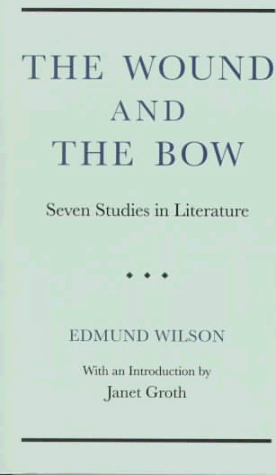 In 1997, not long after I’d gone to work for Ohio University Press, we reissued The Wound and the Bow: Seven Studies in Literature. Edmund Wilson’s essays involve “the delicate theme of the relation between art and suffering,” as Janet Groth puts it in her Introduction.
In 1997, not long after I’d gone to work for Ohio University Press, we reissued The Wound and the Bow: Seven Studies in Literature. Edmund Wilson’s essays involve “the delicate theme of the relation between art and suffering,” as Janet Groth puts it in her Introduction.
The title essay concerns a play by Sophocles about the Greek archer Philoctetes, who bears a suppurating wound on his foot from a snakebite. His groans and his wound’s stench cause him to be exiled on a remote island. But ten years later, when Greece is threatened, his gifts with a bow are needed, and he’s fetched from banishment to become a hero of the Trojan war. Wilson interprets:
The victim of a malodorous disease which renders him abhorrent to society and periodically degrades him and makes him helpless is also the master of a superhuman art which everybody has to respect and which the normal man finds he needs. . . .
It is in the nature of things—of this world where the divine and the human fuse—that they cannot have the irresistible weapon without its loathsome owner, who upsets the processes of normal life by his curses and his cries, and who in any case refuses to work for men who have exiled him from their fellowship. . . .
How then is the gulf to be got over between the ineffective plight of the bowman and his proper use of his bow, between his ignominy and his destined glory? Only by the intervention of one who is guileless enough and human enough to treat him, not as a monster, nor yet as a mere magical property which is wanted for accomplishing some end, but simply as another man, whose sufferings elicit his sympathy and whose courage and pride he admires.
About the time I watched Synecdoche, New York my students were writing memoir essays. One boy was depicting his suicide attempt. He’d been on a football scholarship at another school and had gotten injured, and then his girlfriend back home dumped him. Impulsively he swallowed all his pain pills. His roommate called medics in time.
In the same class was a girl torn up because her father wouldn’t attend church. She and her mother and her sister would dress up, go to mass every Sunday, and then visit a deli for savory treats; but that was Dad’s morning for his garden. His sensitive daughter grieved because of her family’s lost communion, the rightness he’d denied himself and them.
III.
Trouble,
Oh trouble please be kind
I don’t want no fight
And I haven’t got a lot of time
—“Trouble” by Cat Stevens

[Hoffman suffered for authenticity.]
In 2008, the year of Synecdoche, New York, the New York Times Magazine published a profile of Philip Seymour Hoffman by Lynn Hirschberg, “A Higher Calling.” When he was 12, he said, he was transfixed by seeing Arthur Miller’s play All My Sons: “I literally thought, I can’t believe this exists.”
He went on:
When I saw All My Sons, I was changed—permanently changed—by that experience. It was like a miracle to me. But that deep kind of love comes at a price: for me, acting is torturous, and it’s torturous because you know it’s a beautiful thing. I was young once, and I said, That’s beautiful and I want that. Wanting it is easy, but trying to be great—well, that’s absolutely torturous.
This is the theme of Hirschberg’s article. The two specific artistic troubles that rivet your attention in it are allied with but separate from the one of innate gifts and great suffering that Edmund Wilson explores. Other than his boyhood impression (a receptivity that bespoke his great gift), what Hoffman focuses on are the existential difficulty of making art and the emotional price of doing so.
For art is made of emotion and asks for an emotional response—and gets it first from the artist himself. I doubt the psyche can tell the difference, if there is one, between old pain rekindled for art’s purposes and pain imagined for a role about someone living and dying in despair. Like Willy Loman and Truman Capote, to name only two more of the indelible characters Hoffman brought to life.
When Hoffman died, I recalled Heath Ledger’s similarly wrenching work and tragic fate. And the late James Gandolfini, who revealed that he entered therapy as a result of portraying the tortured mob boss in the Sopranos, and whose alarming weight gain in the role and his subsequent fatal heart attack seemed connected to it as well.
About the difficulty of his work, Hoffman explained to Hirschberg:
Creating anything is hard. It’s a cliché thing to say, but every time you start a job, you just don’t know anything. I mean, I can break something down, but ultimately I don’t know anything when I start work on a new movie. You start stabbing out, and you make a mistake, and it’s not right, and then you try again and again. The key is you have to commit. And that’s hard because you have to find what it is you are committing to. . . .
On every film, you’ll have nights where you wake up at two in the morning and think, I’m awful in this. You see how delicate it is—a little movement to the right or the left, and you’re hopelessly hokey.
This is the beginner’s blank state that any art endlessly requires. It can be energizing; it can be exhausting. But for sure it is at least a little scary, as Hoffman’s comment indicates. In an echo of his riff in Almost Famous about being authentic rather than cool, he told Hirschberg, “I know there are actors out there that present themselves as cool cats, but you better take your cool-cat suit off if you want to act. You can’t otherwise.”
And then there’s the outfall of experiencing another’s emotional pain to portray it. He won an Oscar for his depiction of Truman Capote in Capote, but with Hoffman always in character and with the upsetting subject matter, it was reportedly an emotionally bleak set. He told Hirschberg:
With Capote, the part required me to be a little unbalanced, and that wasn’t really good for my mental health. It was also a technically difficult part. Because I was holding my body in a way it doesn’t want to be held and because I was speaking in a voice that my vocal cords did not want to do, I had to stay in character all day. Otherwise, I would give my body the chance to bail on me.
At the time of his interview, to prepare for a role about a character who always listened to music wearing earphones, Hoffman had been listening to “Trouble” by Cat Stevens on earphones. Repeatedly. “A lot of times,” he told Hirschberg, “a song will let you down halfway through, but that song is great to the very end.”
Indeed it is. And I’ve learned there’s an interesting story about it. When Stevens was 19 he fell from his show business perch into a stark old ward of King Edward VII Hospital, in Midhurst, England, where he was told he had but weeks to live. It seemed he had a collapsed lung and was afflicted with tuberculosis. In three months there in a tiny barren room, with people all around him dying, he felt he’d spent his life asleep. In the nine months of bed rest at home that followed his survival and release, he wrote “Trouble” and dozens of other songs.
I’ll never be able to listen to “Trouble” without thinking of Philip Seymour Hoffman. And if you listen, too, and you think about Hoffman’s stunning work and his brave struggle to make it, you might cry.
~
I don’t remember why, but my plans for a third consecutive viewing of Synecdoche, New York got derailed. I was left wondering whether I could keep my lazy mind from wandering a bit where the film gets uber strange. Even though that’s where, or right after, it made my mouth fall open.
How I remember those two kids in my class the winter of Synecdoche—how I tried to help them to make art from their wounds. Honestly, at first the girl’s distress surprised me. That’s it? The boy seemed fine—he was excited about his structure, modeled on the movie Crash—but hurt still lingered in her eyes. Maybe her father’s Sunday choice was enough; maybe it was emblematic. And I could not, I saw, put a scale to my students’ suffering and lessen hers in relation to his. Pain is pain. It knows no measure aside from what’s inside one breast.
And this is why an artist’s authentic and therefore beautiful song, whether crafted from woe or joy or both, resonates for us all.
January 30, 2014
Upon reading Anna Karenina

[View from my classroom, January 29, 2014. Westerville, Ohio, feels very Russian.]
Art, emotion, ego & spirituality in Tolstoy’s masterwork.
Tolstoy is a magnificent writer. He is never dull, never stupid, never tired, never pedantic, never theatrical!—James Joyce
The book floats in some charmed section of the lake of literary opinion where the ripples from modernism and the ripples from Hollywood overlap without merging.—James Meek, on rereading the novel, in the Guardian
More than any other book, it persuades me that there is such a thing as human nature, and that some part of that nature remains fundamentally unaffected by history and culture.—Francine Prose, in the Guardian
 [4th draft of Anna Karenina's opening.]
[4th draft of Anna Karenina's opening.]As I said in my first post about reading Anna Karenina, I picked the translation by Richard Pevear and Larissa Volokhonsky based on its opening line—”All happy families are alike; each unhappy family is unhappy in its own way”—liking their version’s phrasing and punctuation, as well as the opening sentence of the second paragraph.
It took me a couple of weeks to read the 817-pager, and in the process I learned that Leo Tolstoy can do anything as a writer. And he wants to do a lot. A couple of times he goes into the mind of a dog and makes it feel easy and natural. I was impressed by the way he traces shifting human emotions, shows how people get embarrassed, get angry, change their minds, rise above ego and fall to it. In Anna, people blush—a lot. I imagine this is historically accurate, and makes me realize one way we’ve changed, our shifting shame points, though the same conflicts remain.
But more than this, Tolstoy excited and touched and astounded me with his depiction of the way people read each other—their feelings and even their plans shifting as they interpret facial expressions, body language, and comments that might say one thing and mean another. This complex inner ballet is in response to cues they’re picking up from each other or to feelings they can’t suppress. He’s obviously studied himself and others like a scientist.
Anna is a tragic figure but a very human one; famously the novel indicts social mores and hypocrisy, showing how social shunning plays out in a highly stratified patriarchal society in which affairs were countenanced but not serious love affairs. Yet because Anna’s fully rounded, this is the least of it; what lingers in your mind is her own nature, especially her mistakes, and how she crumbles mostly because she loses custody of her beloved son. Both her husband and her lover are unworthy of her, but she’s unworthy of herself.
The novel’s religion theme fascinated me. Almost everyone’s a nonbeliever, at least privately; then one character’s spiritual yearning and his breakthrough to a belief in Christian goodness (without having faith in a deity) become an impressive if mystical climax. And I’m still thinking about a passage that explores Tolstoy’s views of art and artistry.
Admittedly these may seem digressions, especially the religion one for most contemporary readers. The novel’s true digressions into civil service, farming, and politics can surely lose any reader briefly. Yet Tolstoy handles them well, even so. I loved the farming material, of course, and blanked out a few times on the other topics. How much to fault a writer or a book for this? It’s kind of like criticizing a cathedral because, while grand, it’s really too big and your feet got sore.
Anna’s vast swaths read like a dream. Tolstoy’s sentences are so stately, elegant, and rhythmical that once you get accustomed to them other rhythms can jar you. The first book I started afterward, I felt whiplashed. A celebrated memoir of place, written in a spare poetic and much more compressed style, almost telegraphic, it seemed to be missing transitional sentences. Nope, just a Tolstoy hangover.
Something that makes Anna Karenina easier to read, despite its length, than one might expect of a doorstopper 19th-Century novel is that, like Moby-Dick, its chapters are short. In Anna, they come in sets, like waves. After three or four chapters within the same scene/topic, there’s a big new wave: a shift to a new thread. That’s where I often stopped for the night, my brain rebelling at the effort of immersing in a new setting; though Tolstoy is easy to read, his prose like water, usually I got out my bookmark after finishing one set, depending on how much time I had.
Most of Tolstoy’s chapters don’t need to be broken that way—they could’ve been passages separated by space breaks, which Tolstoy also uses. But the short chapters make the book seem very user-friendly and also modern. They may be the mere consequence of the fact that its first publication was in serial form. According to Wikipedia, Anna was published in serial installments from 1873 to 1877 in the periodical The Russian Messenger. It was the Sopranos, the Wire, the Breaking Bad of its day.
As I mentioned previously, reading Anna is part of a larger experiment: using Vladimir Nabokov’s Lectures on Russian Literature as my guide to some classic novels. That probably was my intent when I bought Nabokov’s book over 30 years ago, in 1981. So I’ve started. I’m now reading Nabokov’s analysis, and his insights help illuminate the text, though predictably he abhors Tolstoy’s essaying and preaching that I tolerate or adore. I may revisit this topic once I’ve finished Nabokov’s analysis.
Meantime I’ve also watched the latest movie version starring Keira Knightley. Enacted on lavish sets, it has a delightful theatricality and seems to yearn toward becoming a musical. I loved it.
January 22, 2014
Creating Creativity
![[Belle at the beach, January 2014.]](https://i.gr-assets.com/images/S/compressed.photo.goodreads.com/hostedimages/1390484340i/8225684._SX540_.jpg) [Belle at the beach, January 2014.]
[Belle at the beach, January 2014.]Several recent books for writers to consider.
Painting Your Way Out of a Corner: The Art of Getting Unstuck by Barbara Diane Barry. Tarcher/Penguin 208 pp., $18.95 paperback. Also available in ebook versions. January 16, 2014.
Wake Up & Live! by . Tarcher/Penguin 192 pp., $15.95 paperback. Also available in ebook and audiobook versions. Originally published 1936; reissued September 13, 2013. (FYI: In the public domain.)
Guest Review by Lanie Tankard
True creativity often starts where language ends.
—Arthur Koestler, The Act of Creation
Writer’s block is an expression introduced by psychoanalyst Edmund Bergler in 1947.
Certainly all kinds of tips and rules abound for polishing the craft of writing:
• Show, don’t tell.
• Develop your characters.
• Use dialogue.
Yet at some point, most writers get blocked. Then what?
Creativity is the ability to generate original notions or think of different slants. Which techniques can jumpstart new ideas?
Barbara Diane Barry suggests artistic expression as a solution in her new book Painting Your Way Out of a Corner: The Art of Getting Unstuck.
She established a program called Art for Self-Discovery in New York City, and offers ways to get the creative juices flowing again for anyone—writer or not.
One method is a painting journal, tapping into a side of the brain usually left idling by those who put pen to paper or fingers to keyboard. Eons ago, written stories did not originate in words, but rather in pictures. Cave drawings, hieroglyphics, symbols, and ideograms were all ways of telling tales. Barry’s exercises, such as The Painted Word and Branching Out, make it easy for a reader to pull from such ancient forms and begin painting.
Barry presents concepts from psychology and neuroscience to stretch your imagination’s “weak muscles.” She refers to books such as My Stroke of Insight by Jill Bolte Taylor. She draws on archetypes and myths as well as fMRI.
By losing control, Barry says, you can “invent with abandon” if you eschew perfection. A necessary element of creativity is to “do nothing,” she stresses. Applauding mistakes, Barry believes they lead to new possibilities, pathways, and perceptions. Her motto is: Let Accidents Happen, and her painting journal idea is a useful one for writers to try.
Here is a video of Barry discussing her book:
Painting Your Way Out of a Corner would be a good companion to Drawing on the Right Side of the Brain by Betty Edwards and The Artist’s Way by Julia Cameron. Barry mentions both books.
Two relevant concepts not brought up are Mihaly Csikszentmihalyi’s Flow and Edward de Bono’s Lateral Thinking. De Bono believes creativity “involves breaking out of established patterns in order to look at things in a different way.”
Dorothea Brande’s principle for freeing creativity
 [Original cover.]
[Original cover.]That’s just what writer Dorothea Brande did a generation ago when she put forth a guiding principle for the development of creativity. Her 1936 book, Wake Up and Live!, is now in the public domain and was reprinted in a handy paperback last fall.
Brande also utilized psychological tactics honed from a successful editorial career in an earlier 1934 book, Becoming a Writer, in which she fashioned a prescient strategy for those who place words on a page.
Brande took a no-nonsense approach. “Clear out,” she counsels in Wake Up and Live!, “all the fears of looking ridiculous.” In the upbeat spirit of her time, when Dale Carnegie’s How To Win Friends and Influence People and Norman Vincent Peale’s The Power of Positive Thinking motivated readers, Brande’s book inspired authors. She realized the connection between persona and writer’s block, believing “it takes energy to fail.”
Harnessing Hans Vaihinger’s “As If” philosophy for her foundation, Brande cultivated a powerful mantra:
Act as if it were impossible to fail.
[Brande redux.]
She supplies a set of questions to ask oneself before sending a work into the world—a final checklist before launch. Brande’s Twelve Disciplines could give writers who have run aground a few novel activities to try. Obviously parts of the book are dated, yet it still retains a strong viewpoint relevant today.Dorothea Brande references Freud while Barbara Diane Barry quotes Jung, but the mindset matters little here. These two additions to an author’s first-aid kit are both therapeutic in the treatment of writer’s block.
Lanie Tankard is a freelance writer and editor in Austin, Texas. A member of the National Book Critics Circle and former production editor of Contemporary Psychology: A Journal of Reviews, she has also been an editorial writer for the Florida Times-Union newspaper in Jacksonville. [Photo by Jim Susman, AIA.]
January 15, 2014
Collateral damage
 [Rainbow off Melbourne Beach, Florida, January 5, 2014.]
[Rainbow off Melbourne Beach, Florida, January 5, 2014.]Q&A: Thomas Larson on his new memoir, heart disease & diet.
The Sanctuary of Illness: A Memoir of Heart Disease by Thomas Larson. Hudson Whitman, 128 pp.
My father’s first heart attack when he was 49, on Thanksgiving Day 1968, marked one of those before and after divisions in a family’s life.
The orange-and-white ambulance in our driveway heralded Dad’s long hospitalization and Mom’s palpable fear—her lecture about having to prepare him a special diet was itself a scary rift to me at age 12—and then his Schwinn for exercise that replaced our family boat. A new nomenclature, too: angina, myocardial infarction, dietary cholesterol, building collateral blood vessels, congestive heart disease. Dad suffered another heart attack in 1979, as a hurricane hit our county in Florida. In 1984, up in Illinois, my half-brother, age 44, sustained his own infarction. In 1989, Dad, his scarred heart barely beating, succumbed at age 71.
No help from Mom’s genetics. She got bypass surgery for four blocked arteries in 1993. “The Rounsaville blood,” she told me, “is like sludge.”
With my family’s doom-laden cardiovascular history, reading The Sanctuary of Illness: A Memoir of Heart Disease was a visceral experience. As a good memoir will, it makes real one person’s inner and outer experience—gives you that experience. It both inspired me as a writer and animated my natural desire to escape, for as long as possible, the saving but cold ministry of the medical establishment.
Author, journalist, and critic, Thomas Larson has been a staff writer for the San Diego Reader for 14 years. My full review of his The Sanctuary of Illness appears on the Brevity Nonfiction Blog. Larson answered some questions for Draft No. 4 about writing and the heart:
Q. You’re an expert on the memoir genre, having published The Memoir and The Memoirist: Reading and Writing Personal Narrative (reviewed). It seems you set a high bar there, declaring that self-disclosure rather than dramatic event sequence is memoir’s reason for being. How did your knowledge of the field help or complicate the writing of your first book-length memoir?
 [Thomas Larson.]
[Thomas Larson.]I’d phrase my book’s summation, which may have been more implicit than explicit in M&M, as such: self-disclosure is the outcome of dramatic events, which also may result from the drama of intellection, breaking through to insight as event. Put as a question, what has our writing style or choice of form led us to discover about ourselves that we didn’t know until we wrote a memoir?
This idea is core to my books whenever they use memoir elements or are memoir. The dramatic revelation about the self is key. The dramatic revelation in Sanctuary is the realization that Suzanna and I dwell in this protected space where we are aware and unaware, simultaneously, of the disease’s hold upon us—its acute attacks and its chronic dread. This is what the writing pushed me toward and thus it appears toward the end of the book as destination (true to how I experienced it), an emotional destiny if you will.
If I accomplish this in the book, it’s because I read as a writer/critic and reviewed many memoirs. Eventually, I came to see how primary such dramatic insight into the self in the books I valued was. That’s why I valued them. Once I saw this feature of contemporary memoir, I said to myself, I’m going to try and do that, too.
Q. The Sanctuary of Illness is rich in metaphors. Did they arise “naturally,” so to speak—provoked and partly furnished by the nature and inherent drama of your experience, such as your son “too shocked to deal with his old man’s sail, blown and tattered by the death gale”—or were they something you created more consciously? Of possibly the latter, I’m thinking of your describing your jotted questions for a doctor that lie on the page “like tree-dropped apples on verdant ground.” And however you created them, how can writers increase the use of metaphors in their own work?
Either you have a metaphoric spark or you don’t—Raymond Chandler was one of the best (“I belonged in Idle Valley like a pearl onion on a banana split”) while Hemingway was the worst. And yet Ernest made up for it in other ways: that chilly Anglo-Saxon declamation of his in which most things are glass-cased in their pure nominatives: rock, wind, road, pine tree, river, woods, and snow.
I’ve tried to analyze my penchant for metaphor and I can’t find the underground lake on which the sprites of my ingenuity launch their little boats. There. Came to me on the first try, though I smoothed out the phrase. They do just appear, as sadness’s visage is my mother’s face.
My sense, also, is that my music background (musician/composer until 33) did much to move my comparative imagination from a musical to a lexical fount; actually, they still go back and forth, like dogs and cats that grow up together.
Music itself is a metaphor for writing/speaking; so I’ve had much practice, more than most, in swirling and catching my thought-sound shapes. To me, words are like sounding objects and musical phrases are like characters speaking lines in a play or authors crafting bon mots.
Q. You allude to your ongoing journaling during your long health crisis and also to being able to draw on past journals to remember your history. Could you discuss your journaling practice and explain its role in your memoir-writing? Was it useful for The Memoir and the Memoirist or for your second book, The Saddest Music Ever Written The Story of Samuel Barber’s “Adagio for Strings” (reviewed), which has memoiristic aspects?
 [Thomas Larson.]
[Thomas Larson.]I have 33 years’ worth of journals, and, prior to 1980, many music composition notebooks as well.
My logs tend to be about the many tornadic dramas in my life, rendered in and of and for the moment—which, as we know, often never ends.
I made a discovery when I worked on Saddest Music, a hybrid work that contains actual and imagined memoir scenes, that is, the experiences of my parents and my grandparents before I was born. I learned to journal (free write/recreate) such scenes or intensities with writing prompts (these can be found on my website), emphasizing the dissembled stained-glass approach to CNF.
I take a scene (I may or may not have written it down the day after it occurred: let’s say the night I spent in a ward, post-op heart attack #1) and I catalog all its sense elements (what do I see, hear, touch, etc.). Then I dwell, feel/re-feel the hottest, the most intense sensory parts (the scraping sound of the curtain on the steel rods around my bed as they are opened by doctors, nurses, visitors). Then I exaggerate, but not a lot, these details via metaphor or musical phrases (“the ticking of the hooks, scraping along the runnel”) and I think I’ve got something: felt language, felt in the sounds they occupy together.
The idea is to get the words of a sentence to listen to each other as musical notes in a fine melody might listen to one another, that is, where they’ve been and where they’re going. “Somewhere over the rainbow, way up high.” That last phrase made melodic: way leaps to up and falls to high. Can you hear the play and counter-play? Such sounding relationships are always available to writers to uncover. Certainly, reading aloud helps.
This is the sort of thing I improvise on in my journal, especially in the throes of crafting a book. Writing generates writing, yes?
Q. Okay, a dumb question. With all our medical technology, why is it still apparently so hard (or cost-prohibitive?) to determine if someone’s arteries are getting clogged, putting him or her at risk for a heart attack? It seems by now there would be a fast, easy way for doctors to see the percentage of restriction in each cardiac artery.
They’re working on it. Sending catheters up the pencil-thin arteries with scopes and measuring devices is possible to make plaque readings, but we still need to refine those tools down to nanotechnology so we aren’t disrupting the integrity of the arteries themselves. You are right: an angiogram can show, via the fluoroscope, the degree to which the arteries are occluded. Problem is we would have to spend billions doing this on everyone, say at 50, and it may or may not be preventive. My blockages could have been seen and treated prior. But they still would have grown back. Also, remember that the majority of heart attacks are sudden occlusions, not slow-building occlusions over time.
Q. After three heart attacks, you’re now on the proverbial nuts and berries regimen—except no nuts. And no animal protein; no fats of any kind. You eat mostly raw, plant-based food except for sourdough bread, Ezekial cereal, coffee, Chai, strawberry preserves, and vanilla soy milk. Many people probably doubt they could sustain such a rigorous and abstemious diet. And even with a strong desire, America’s food chain is awash in animal fats, sweeteners, and oils—which are added even to “organic,” “health food,” and “vegetarian” products. Do you have any tips for those who are trying to take baby steps toward reducing their total dietary load of bad stuff?

[Thomas Larson.]
A longtime veggie, I decided many years ago that food is not a source of pleasure. I don’t have a Saks Fifth Avenue palette. I’m plebian, proletarian in this regard. My tastes lie in memoir, music, and the ebb and flow (mostly ebb) of the literary author in mass, mediated society. Plain food tastes fine to me, the plainer the better. Actually, if you commit to a no-oil Vegan diet, the only thing that is, for me, preventing another heart attack and maybe reversing the disease, then it’s easy. You can’t eat anything but raw or near raw and so dinner’s a done deal.
OK, say you can’t go whole hog—be Vegan one, then two, then three days a week. Incremental. Eat out less and get rid of all crap food in the house. As a kid I ate milk, sugar, Frosted Flakes and got fat. So did my brothers and Dad. Now I eat fruit, whole grain cereal, and soy milk. And I lose weight, cut down on inflammation from animal protein. Put this sign on your fridge: Dairy Is the Anti-Christ. Or: Dairy is the Dick Cheney of health.
Q. Though you sustained some impairment to your heart muscle from three infarctions—you estimate you’ve lost 10 to 15 percent—one gets the impression that you’re in better shape now than when you first collapsed almost eight years ago: 40 pounds lighter, more active, less stressed, consuming a far healthier diet. Could you discuss this irony and perhaps the very inspiring “it’s-never- too-late” implicit message of your story?
These infarcts were non-religious near-death experiences. Luck/fate let me live. I was changed but another I in me didn’t change or limped behind the new stented self I’d become. It was as if I’d been revised—my body, ever a draft, becoming that which it wasn’t, me, an exploded, re-blooded TL whom I wanted to be: the man who survived his disease (so far) and long enough to write its tale and, thus, morph via memoir into (almost) a new character, or new actor playing the role in the last act of his evanescent and curtain-ready five-act play. I’m still trying to catch up to the person medical intervention and veganism has allowed me to become. I’m gaining on me.
Q. What’s your favorite meal for breakfast, lunch, dinner?
I mentioned breakfast. Lunch/dinner are interchangeable; greens cooked or raw, rice, veggie burger, whole wheat pita, salad, vegetables (for example, small potatoes in the crock pot with blackberry vinegar), a frozen fruit bar for dessert. Day-in, day-out. Simple, mostly raw foods. As Michael Pollan writes: “eat food, mostly plants, not too much.” I’m lucky; no food-smothering relatives and even if I did, I just say no thanks. Plus a near-vegan partner.
Eat this way and tell me, post-meal, if you ever feel bloated, sluggish, sleepy, gaseous, lethargic—all states I once knew and now have felicitously fled.
In the Acknowledgments of Sanctuary of Illness, Larson praises the books and outreach efforts by two advocates for plant-based diets, cardiologist Dr. Caldwell Esselstyn and biochemist T. Colin Campbell, authors respectively of the bestsellers Prevent and Reverse Heart Disease and The China Study. Both are featured in a recent documentary Larson also mentions, Forks Over Knives, which cites strong correlations between dietary cholesterol (from meat, eggs, dairy products, and oils) and heart disease and cancer.

